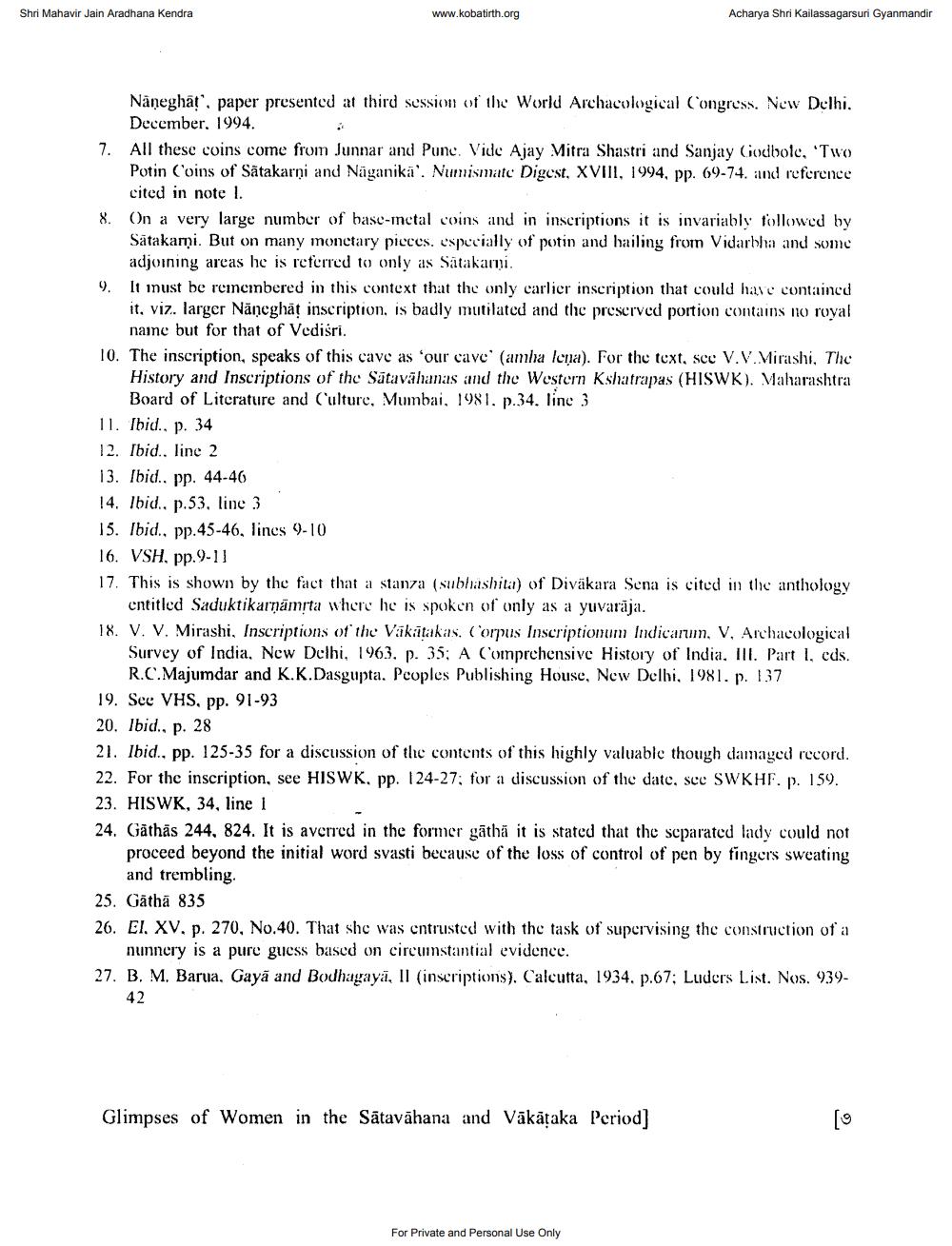________________
Shri Mahavir Jain Aradhana Kendra
www.kobatirth.org
Acharya Shri Kailassagarsuri Gyanmandir
Nāņeghat'. paper presented at third session of the World Archacological Congress, New Delhi.
December, 1994. 7. All these coins come from Junnar and Punc. Vidc Ajay Mitra Shastri and Sanjay Godbolc, 'Two
Potin ('oins of Sätakarni and Nāganikā'. Numismate Digest, XVIII, 1994, pp. 69-74. and reference
cited in note 1. 8. On a very large number of base-inctal coins and in inscriptions it is invariably followed by
Sätakami. But on many monetary pieces, especially of potin and hailing from Vidarbha and some
adjoining areas he is referred to only as Satakarni. 9. It inust be remembered in this context that the only carlier inscription that could have contained
it, viz. larger Năncghät inscription, is badly mutilated and the preserved portion contains no royal
name but for that of Vedisri. 10. The inscription, speaks of this cave as 'our cave' (amla lena). For the text, sce V.V. Mirashi, The
History and Inscriptions of the Satavahanas and the Western Kshatrapas (HISWK). Maharashtra
Board of Literature and Culture, Mumbai, 1981. p. 34. line 3 11. Ibid., p. 34 12. Ibid.. line 2 13. Ibid., pp. 44-46 14. Ibid., p.53, line 3 15. Ibid., pp. 45-46. lines 9-10 16. VSH, pp.9-11 17. This is shown by the fact that a stanza (subhashita) of Diväkara Sena is cited in the anthology
entitled Saduktikarnämrta where he is spoken of only as a yuvarāja. 18. V. V. Mirashi, Inscriptions of the Vākiitakas, Corpus Inscriptionum Indicarum, V, Archacological
Survey of India, New Delhi, 1963, p. 35; A Comprehensive History of India. Ill. Part I. cds.
R.C.Majumdar and K.K.Dasgupta. Peoples Publishing House, New Delbi, 1981. p. 137 19. See VHS, pp. 91-93 20. Ibid., p. 28 21. Ibid., pp. 125-35 for a discussion of the contents of this highly valuable though damaged record. 22. For the inscription, see HISWK, pp. 124-27; for a discussion of the date, see SWKHF. p. 159. 23. HISWK, 34, line 1 24. Găthās 244, 824. It is avcrred in the former gātha it is stated that the separated lady could not
proceed beyond the initial word svasti because of the loss of control of pen by fingers sweating
and trembling 25. Gāthā 835 26. EI, XV. p. 270, No.40. That she was entrusted with the task of supervising the construction of a
nunnery is a pure guess based on circumstantial evidence. 27. B. M. Barua. Gayã and Bodhagayā. II (inscriptions). Calcutta, 1934. p.67; Luders List. Nos. 939
42
Glimpses of Women in the Sātavāhana and Vākātaka Period]
For Private and Personal Use Only




